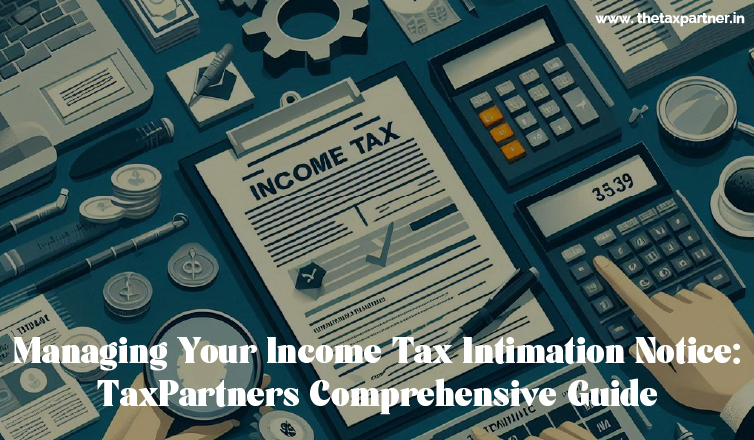Connect with us for all your queries



An Income Tax Intimation Notice is a formal communication sent by the Income Tax Department to a taxpayer after their Income Tax Return (ITR) has been processed. This notice is issued under Section 143(1) of the Income Tax Act, 1961. The primary purpose of this notice is to inform the taxpayer about the outcome of the initial processing of their ITR.
This article provides a clear definition and explanation of what an Income Tax Intimation Notice is, helping taxpayers understand its significance. By outlining the purpose of the notice, the article helps taxpayers grasp why they receive this notice and what it aims to achieve. The article emphasizes the importance of paying attention to the intimation notice, ensuring taxpayers recognize the potential consequences of ignoring it. Readers will find valuable information on the steps to take upon receiving the notice, including how to verify details and address any discrepancies. By warning about potential fraudulent communications, the article aids in protecting taxpayers from scams related to income tax refunds and notices. Ultimately, the article promotes compliance with tax laws by educating taxpayers on the proper handling of intimation notices, reducing the risk of penalties or legal issues.
Understanding and appropriately responding to an Income Tax Intimation Notice is crucial for maintaining accurate tax records and ensuring compliance with tax laws. This article aims to equip taxpayers with the knowledge they need to effectively manage their tax notices and obligations.
Issuance Period: According to the Income Tax Act, the department must issue the intimation notice under Section 143(1) within nine months from the end of the financial year in which the return is filed.
For instance, if the ITR for the Financial Year 2020-21 is filed on or before the due date (typically July 31, 2021), the department must issue the intimation notice by December 31, 2022.
Electronic Communication: The intimation notice is sent to the taxpayer’s registered email ID. Additionally, an SMS notification is sent to inform the taxpayer about the notice.
Understanding the process of issuing an intimation notice helps taxpayers be prepared and ensures they respond promptly to any discrepancies noted by the Income Tax Department. This timely response can prevent further complications and ensure compliance with tax regulations.
Income Details and Deductions Claimed
The intimation notice provides a comprehensive breakdown of the income reported by the taxpayer under various heads (salary, business income, capital gains, etc.) and the deductions claimed (under sections 80C, 80D, etc.). This helps in verifying that the reported figures match the calculations done by the Income Tax Department.
Tax Calculations and Comparison with the Income Tax Department's Assessment
The notice includes a side-by-side comparison of the tax calculations as per the taxpayer's return and the Income Tax Department's assessment. This comparison highlights any discrepancies in income, deductions, or tax liability.
Additional Tax Demand or Refund Information
The notice indicates if there is any additional tax payable by the taxpayer due to discrepancies found during the processing. Conversely, if the taxpayer has overpaid, the notice will show the refund amount due.
Understanding the Intimation Notice
Accessing the Notice-
To open the notice:
Step-by-Step Guide to Reading and Interpreting the Notice
Common Elements in the Notice
By carefully reviewing and understanding each section of the intimation notice, taxpayers can ensure that they are aware of any discrepancies or additional liabilities and take timely action to address them.
Verify Personal Details
Identify Any Discrepancies and Understand Their Implications
Scenarios Covered in the Notice
Income Tax Refund
How to Respond to an Additional Tax Demand
What to Do if a Refund is Due
Precautions and Fraud Prevention
Importance of Verifying Official Communication from the Income Tax Department
Filing Grievances
How to File a Grievance on the Income Tax Portal
An Income Tax Intimation Notice under Section 143(1) is a critical document that taxpayers receive after their ITR has been processed. This notice provides a detailed comparison between the taxpayer's reported income, deductions, and tax calculations, and those assessed by the Income Tax Department. Key steps upon receiving the notice include verifying personal details, comparing the department's calculations with your ITR, and identifying any discrepancies.
The notice can indicate three primary scenarios: no additional tax payable, an additional tax demand, or an income tax refund. Understanding how to deal with each scenario is crucial for maintaining accurate tax records and compliance with tax laws. When discrepancies arise, it is important to take corrective actions promptly, whether it involves paying additional tax or addressing errors in the filing.
Additionally, being aware of potential frauds and verifying the authenticity of communications from the Income Tax Department is essential for safeguarding personal information. In cases where the intimation notice is not received, taxpayers should know how to file a grievance through the income tax portal.
Timely response to the intimation notice is vital to avoid penalties, interest, and further legal complications. By staying informed and proactive, taxpayers can ensure their tax obligations are met accurately and efficiently, thereby contributing to a smoother and more transparent tax filing process.
What is an Income Tax Intimation Notice?
An Income Tax Intimation Notice is a communication sent by the Income Tax Department to taxpayers after processing their Income Tax Returns (ITRs). It summarizes the department's assessment of the taxpayer's income, deductions, and tax liability.
How do I receive an Intimation Notice?
The notice is sent to your registered email ID. You will also receive an SMS notifying you about the email.
What is the purpose of an Intimation Notice?
The notice verifies if the tax calculations in your ITR match those computed by the Income Tax Department and informs you about any discrepancies, additional tax payable, or refunds due.
When can I expect to receive an Intimation Notice?
Typically, you should receive the notice within 9 months from the end of the financial year in which you filed your ITR.
How do I access the Intimation Notice?
It is a password-protected PDF file attached to the email. The password is your PAN number in lowercase followed by your date of birth (DDMMYYYY).
What should I do upon receiving the notice?
Verify your personal details, compare the department's calculations with your ITR, and understand any discrepancies or additional tax demands/refunds.
What if there are errors in the Intimation Notice?
You can file a rectification request online through the income tax portal to correct any errors found in the notice.
What happens if I don’t respond to the Intimation Notice?
Ignoring the notice could lead to penalties or further legal actions. It's crucial to respond promptly and address any discrepancies.
Can I appeal against the Intimation Notice?
Yes, if you disagree with the department's assessment, you can file an appeal or rectification request with appropriate supporting documents.
What does it mean if there is no additional tax payable in the notice?
It means the department agrees with your tax calculations and there are no discrepancies found that would require you to pay additional taxes.
What should I do if there is an additional tax demand in the notice?
Review the calculations and reasons provided in the notice. If you agree, pay the additional tax within the stipulated time to avoid penalties.
How long does it take for a refund, if due, after receiving the notice?
Refunds are typically processed within a few weeks after the notice is issued, provided your bank details are correct and verified.
What should I do if I suspect fraudulent communication related to the notice?
Do not respond to emails or SMS asking for personal or financial information. Verify the authenticity of such communications through official channels.
Can I file a grievance if I do not receive the Intimation Notice within the expected timeframe?
Yes, you can file a grievance through the income tax portal if you do not receive the notice within the stipulated time.
Is it necessary to keep a copy of the Intimation Notice for future reference?
Yes, it is advisable to keep a copy of all tax-related documents, including the Intimation Notice, for future reference and compliance purposes.
Tax Partner is India’s most reliable online business service platform, dedicated to helping you in starting, growing, & flourishing your business with our wide array of expert services at a very affordable cost.